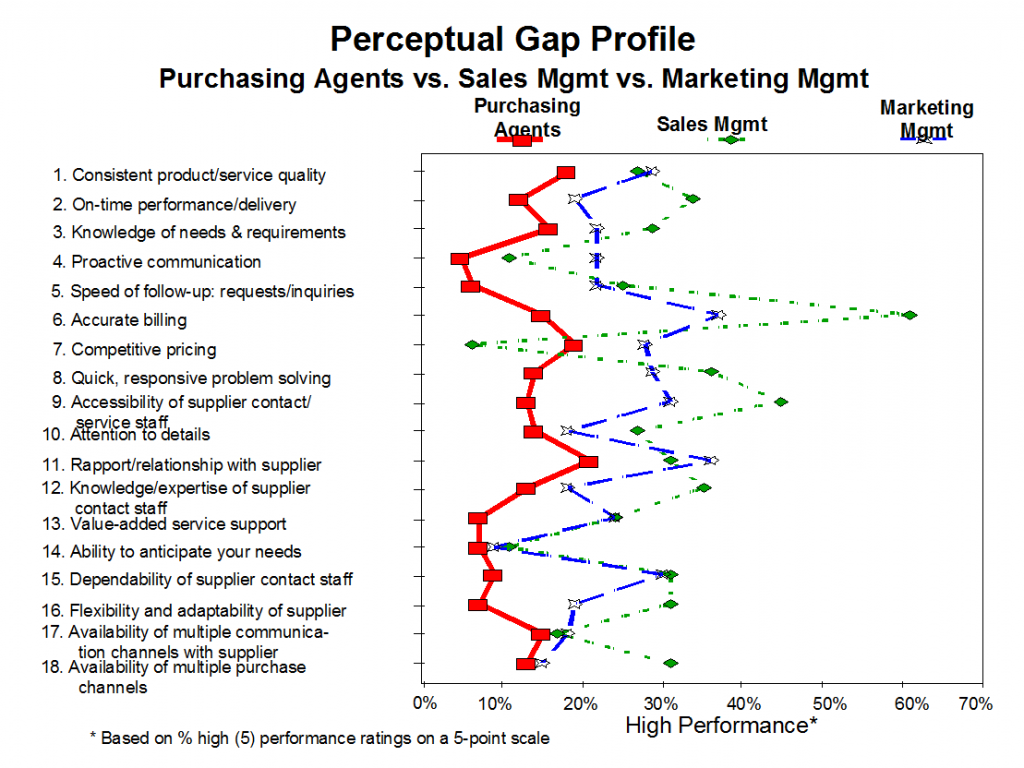Michael Lowenstein, Ph.D., CMC Thought Leadership Principal, Beyond Philosophy
Some may remember an episode of ‘90’s sitcom ‘Murphy Brown’ in which Candace Bergen, as Murphy, is viewing a focus group about her news program, FYI, through the two-way mirror. In a key scene, focus group participants are asked to describe the personalities and presentation styles of various members of the program – beginning with Corky, Frank, and Jim; and they do so in positive, glowing terms. When they get to d escriptions of Murphy, however, the perceptions turn to sharply negative. Murphy is identified as abrasive, abrupt, and insensitive, just a few of the unflattering characterizations of her interviewing and reporting style on the program.
Hearing and seeing this, Murphy jumps from her chair, bursts out of the client viewing room and emotionally confronts the focus group members, asserting that, deep down, she is really warm and caring, and questioning – pleading, really – why viewers don’t see her in that light. Though played for laughs, this scene is all too representative of the value delivery perceptual gaps which often exist between suppliers and their customers. Simply stated, employees frequently see both the importance and the performance of key rational and emotional value drivers very differently when compared to customers.
Years ago, quality guru W. Edwards Deming said that what everyone in a company does can be reduced to one of two functions: a) to serve the customer or b) serve someone who does. So, arguably, understanding where perceptual gaps between employees and customers exist anywhere in the company should be of prime importance to HRD, especially in their capacity of helping optimize the effectiveness of human resources. The reality is that all levels of management should share in this.
In preparation for Customer WinBack, my 2001 book on customer loss and recovery co-authored with Jill Griffin, we conducted original research among purchasing agents and sales/marketing managers to better understand the essential value delivery perceptual differences between customers and suppliers.
Our sample included a statistically valid cross-section of purchasing agents in both business-to-business and consumer product and service companies. Purchasing agents were selected because, while others often influence purchases and may even be instrumental in decision-making, it is the purchasing agent who usually has the most day-to-day contact with suppliers. Sales managers from business-to-business and consumer product and service were selected because they offer an overall perspective of the entire selling and support process. Finally, marketing managers were included because they are frequently responsible for their company’s communication efforts.
One of the first things we wanted to learn from the purchasing agents was whether they saw their suppliers as commodity-oriented, i.e. providing competitive prices and basic service and support, or customer-oriented, working to deliver optimum value and benefit. Customer-orientation, which emphasizes relationships and high customer commitment and advocacy, correlates very closely with customer loyalty behavior.
Only 43 percent of the purchasing agents said their suppliers were customer-oriented, compared to 73 percent of the sales managers and 71 percent of the marketing managers who thought that purchasing agents would consider them customer-oriented. This significant difference was a telling clue into the degree of misinterpretation and misperception between customers and suppliers. The two groups are not speaking the same language, struggling to make one another understood. It’s also critical to understanding why the level of customer defection is so high at most companies.
We asked each group to assess the importance and performance of close to twenty elements, or attributes, of value delivery. These included both functional, or rational, attributes and emotional, or relationship, elements. Like the results to our first question, these findings were no less sobering and revealing. Other than pricing, need anticipation, and communication channel availability, purchasing agents consistently gave high attribute ratings far less often than sales and marketing managers. Many of these differences were in relationship and communication areas, essential in leveraging customer advocacy.

We’ve frequently found that customers consider the emotional, relationship and other intangible aspects of value delivery – trust, communication, interactive/collaborative components of service, anticipation of needs, brand equity, etc. – much more important, and more leveraging of behavior, than the functional aspects. Customers tend to see the functional aspects of delivery as more basic and expected, in other words one-dimensional and non-differentiating. For companies involved in business-to-consumer products or services, the emotional and relationship elements of delivery may represent 70%, or more, of what drives supplier choice and loyalty decisions. This, somewhat surprisingly, is similarly true for business-to-business products and services; so understanding perceptual differences between staff and customers should be a priority for senior corporate management as well as managers in Sales, Marketing, and Customer Service.
When companies are innovative and inclusive with staff, all parties benefit. The company gets more effective employees. Employees like the participation and learning. Customers like the improved processes. Another key advantage of conducting employee ‘mirror’ research, and one not to be overlooked, is that, in all likelihood, competitors don’t have this kind of insight. They’re hearing only from the external constituent group, the customers, but not from the equally important representatives and deliverers of value, company employees.
So, recommended prescriptives:
Research Field Design – When you are conducting experience research among customers, make certain to include at least one cross-sectional cell of employees. Better still, include enough employees so that segmentation by function, location, tenure, management level, etc. can be factored into analysis.
Questionnaire Mechanics – Ask employees to rate elements of delivery, but with a slight twist. Ask employees to rate the elements of delivery as they think customers will. That way, you’ve set up a ‘mirroring’ protocol, where you’ll be able to get a read on how employee perceptions of value synch up with those of customers. Also, and tot inconsequentially, include a read on emotional perceptions of experience performance (from both customers and employees)
Spread the News – As an ongoing component of training, customer and employee research results should be shared with employees, either embedded in other instruction programs or as a one-off whenever customer experience research is conducted.
Republished with permission from CustomerThink.com
| Michael Lowenstein provides strategic consulting, research design and in-depth, leading-edge analysis that helps clients deliver outstanding business results through deeper customer experience, communication, relationship, employee and brand equity insights. Beyond Philosophy provide consulting, specialised research & training from our Global Headquarters in Tampa, Florida, USA. |


